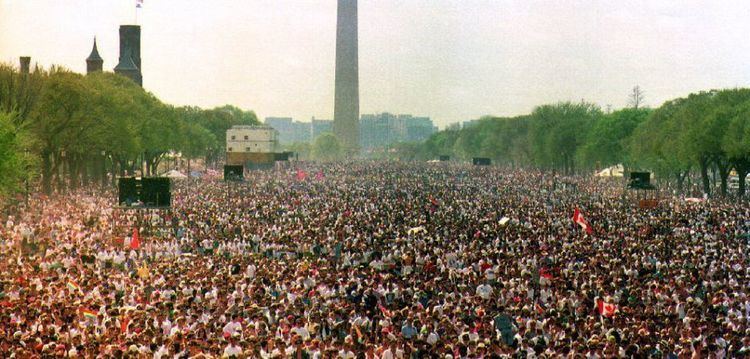Start date April 25, 1993 | ||
 | ||
The March on Washington for Lesbian, Gay, and Bi Equal Rights and Liberation was a large political rally that took place in Washington, D.C. on April 25, 1993. Organizers estimated that 1,000,000 attended the March. The D.C. Police Department put the number between 800,000 and more than 1 million. The National Park Service estimated attendance at 300,000, but their figure attracted so much negative attention that it shortly thereafter stopped issuing attendance estimates for similar events.
Contents
Background and planning
Between the 1987 March on Washington and the early 1990s, LGBT people achieved much more mainstream visibility than they ever had in the past. The LGBT community still faced widespread discrimination, through such policies as Don't Ask Don't Tell, Colorado's constitutional amendment (1992) invalidating laws that prohibited discrimination on the basis of sexual orientation, and rising instances of LGBT-targeted hate crimes. In this climate, Urvashi Vaid of the National Gay and Lesbian Task Force spearheaded the movement for a third LGBT March.
In January 1991, she sent a letter to LGBT organizations across the U.S. to garner support for a third march and to invite them to send delegates to a planning meeting on March 9, 1991, in Washington, D.C. No consensus was reached regarding the march's potential date at this meeting, so a second meeting was arranged for the weekend of May 11–12, 1991, again in Washington. This meeting provided the mandate for the march: to rebuild and reinvigorate local and national activists. Additional organizational meetings took place in Chicago (August 1991), Los Angeles (January 1992), Dallas (May 1992), Denver (October 1992) and Washington DC (February 1993).
Platform and demands
March organizers agreed upon seven primary demands, each with further secondary demands. The primary demands were:
Speakers and events
In the days surrounding the March, a wide range of events serving different groups within the LGBT community were held in and around Washington, DC. These included historical exhibits, religious services, lobbying events, social gatherings, art exhibits, political workshops, public service events, and candlelight vigils.
The day before the march, two demonstrations raised the issue of same-sex marriage. About 1,500 same-sex couples assembled at the National Museum of Natural History with, according to the Washington Post, "a dozen ministers, organ music, photographers and rice". A far smaller gathering of several same-sex couples protested in front of the Internal Revenue Service building and performed a symbolic wedding ceremony titled "an Interfaith Ceremony of Commitment". According to the Chicago Tribune, the demonstration's point was a demand "for full legal recognition of domestic partnerships" for tax purposes.
Speakers and performers at the rally following the march included Judith Light, Melissa Etheridge, RuPaul, Madona, Martina Navratilova, Ian McKellen, Eartha Kitt, Lani Ka'ahumanu, Urvashi Vaid, Jesse Jackson, and Martha Wash. Lani Ka'ahumanu was the only out bisexual to speak at the rally out of 18 total speakers; she had conceived and led a successful national campaign to have bisexual people included in the title of the march.
